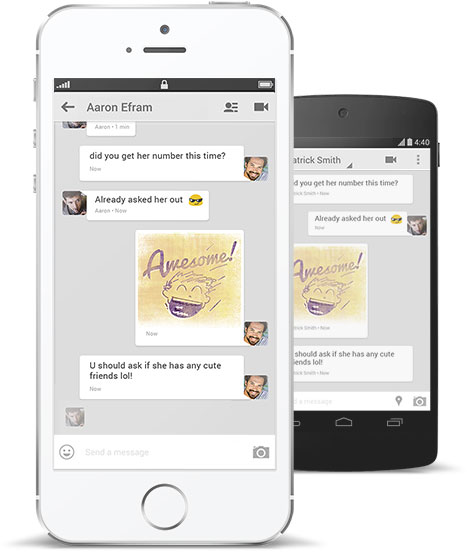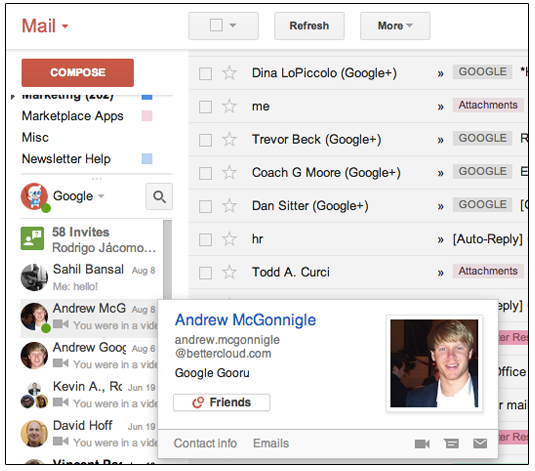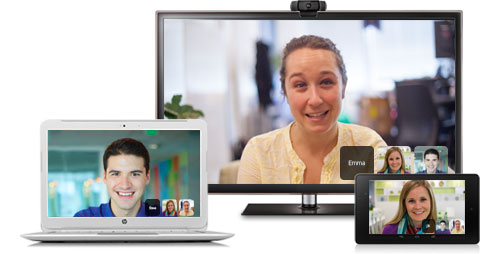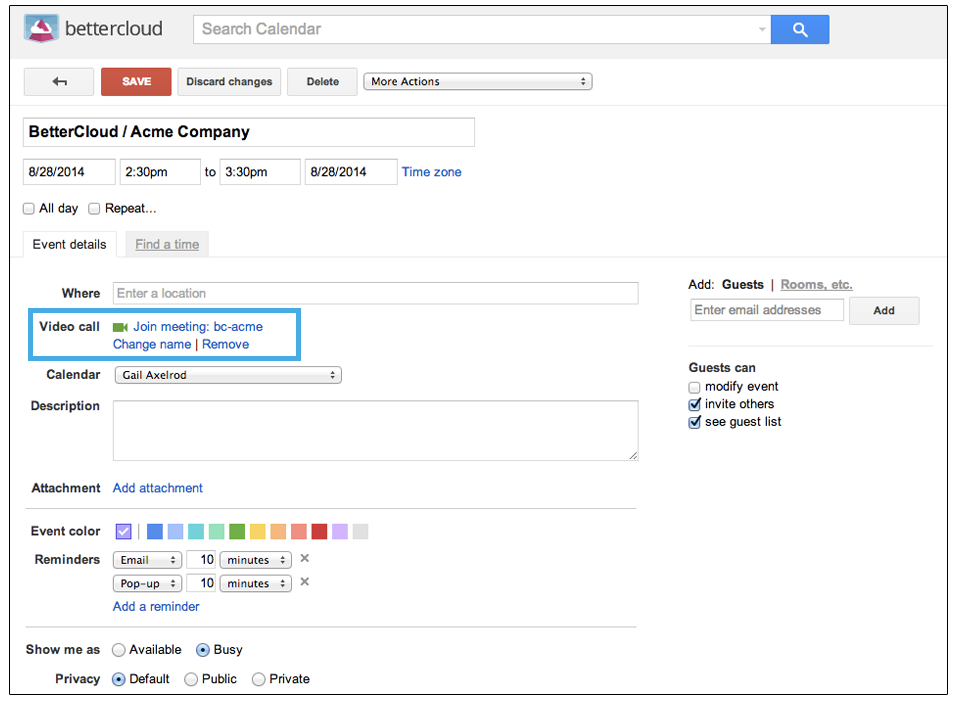How Google is Disrupting the Enterprise (Again) with Hangouts
August 21, 2014
5 minute read

When Google launched Talk in 2005, the company changed the way many of us communicate. The downloadable application allowed users to instant message quickly and easily. Definitely not revolutionary technology (long before Talk I was an early adopter of AOL’s AIM service), but still the application introduced millions to another Google product and paved the way for the company’s unified communications platform. In 2006, Google rolled Talk into Gmail, making the application an integral and beloved aspect of the mail client.
Laying the Foundation for a Unified Communications Platform
 Since it’s launch, Google has continually built out Talk functionality steadily adding power-house features like group chat and voice and video calling. But, the biggest change to Talk came last year, when in a series of huge announcements, Google introduced Hangouts, the company’s first true unified communications platform.
Since it’s launch, Google has continually built out Talk functionality steadily adding power-house features like group chat and voice and video calling. But, the biggest change to Talk came last year, when in a series of huge announcements, Google introduced Hangouts, the company’s first true unified communications platform.
Upon launch, Hangouts replaced Google Talk, Google+ Hangouts and Messenger and finally delivered a native messaging application to iOS users. (Despite the name change, a Google+ account was still required to use Hangouts until very recently, but more on this later).
Unification Pays Off as Hangouts Use Grows
Since its launch last year, Google has focused tremendous resources into building Hangouts into an enterprise-ready messaging service. And these efforts are paying off. In a survey of our customer base conducted earlier this year, we saw a huge uptick in the use of Hangouts among Google Apps customers compared to the previous year.
Clearly, companies operating on Google Apps are making an effort to actively use Hangouts in their organizations. And the integrated nature of the product (not to mention the fact that Hangouts are included in the cost of a Google Apps license) is motivation for organizations to deprecate their use of more traditional web conferencing services like GoToMeeting and Webex, both of which not only cost more than Hangouts, but require the installation of a plugin.
Consumerization of IT and Passive Adoption of Hangouts in the Workplace
 Speaking of integration, while there’s no doubt that companies are actively encouraging employees to communicate via Hangouts to cut costs, passive use and the consumerization of IT are also contributing to Hangouts growth in the enterprise.
Speaking of integration, while there’s no doubt that companies are actively encouraging employees to communicate via Hangouts to cut costs, passive use and the consumerization of IT are also contributing to Hangouts growth in the enterprise.
For Google Apps users who also actively use Gmail for personal email, Talk and now Hangouts have been a crucial part of the Google experience. Just think of how easy it is to go to your chat list, select a friend and start a text, voice or video call with that user. Slowly, this experience has trickled into the workplace, where video conferencing has become essential in our ever-expanding work-from-anywhere world.
Other thoughtful integrations, like Google’s move to automatically add a Hangout to every calendar event has further expanded Hangouts’ adoption. Plus the messaging system’s ubiquity across the Google platform and user friendly mobile applications make starting a Hangout from anywhere, at any time simple and easy.
Appealing to the Enterprise
As the use of Hangouts in the enterprise has increased, Google has made a concerted effort to step up the professional viability of the platform. As noted earlier in this post, Google just recently moved to decouple Google+ and Hangouts, an upgrade embraced by Google Apps customers that often disable the use of Google+ altogether. While consumer Gmail users are still obligated to create a Google+ account in order to use Hangouts, this update vastly increases the appeal of Hangouts as a replacement for mainstay web conferencing tools. In the same update, Google also put the messaging service in line with Google Apps’ SLA, guaranteeing 99.9% reliability and access to 24 / 7 phone support. Plus, Apps customers can now start or join a Hangout with up to 15 people.
Chromebox for Meetings
 To further grow Hangouts’ adoption, Google released Chromebox for Meetings, a hardware and software product, this February. CFM takes the best of Hangouts and Chrome OS to bring users an all-cloud, always-on video experience – think Tandberg for the modern cloud era. But, unlike legacy video conferencing systems, Chromebox for Meeting does not require any special network configuration like static IP addresses, port forwarding or inbound firewall rules. This means that even small organizations without a dedicated IT or network team can easily set up CFMs by connecting the devices to any standard ethernet or WiFi connection. CFMs don’t require expensive dedicated lines, proprietary networks or internal support teams – just give the device any broadband internet connection, register it once with your Google Apps domain and it’s good to go.
To further grow Hangouts’ adoption, Google released Chromebox for Meetings, a hardware and software product, this February. CFM takes the best of Hangouts and Chrome OS to bring users an all-cloud, always-on video experience – think Tandberg for the modern cloud era. But, unlike legacy video conferencing systems, Chromebox for Meeting does not require any special network configuration like static IP addresses, port forwarding or inbound firewall rules. This means that even small organizations without a dedicated IT or network team can easily set up CFMs by connecting the devices to any standard ethernet or WiFi connection. CFMs don’t require expensive dedicated lines, proprietary networks or internal support teams – just give the device any broadband internet connection, register it once with your Google Apps domain and it’s good to go.
Since CFM’s release, Google has stepped up functionality with new features like dual monitor support, personal calendar integration and admin functionality allowing IT pros to manage meetings remotely through the Google Apps Admin Console. And a little known feature we use everyday at BetterCloud makes CFM vital to every meeting. Using the URL g.co/present, meeting attendees can easily select their meeting via the CFM and join to screenshare, esentially replacing the need for an HDMI connection and even Chromecast.
Expanding the Hangouts Partner Ecosystem
Google is also increasing partnerships around its Hangouts service to provide more tools for the enterprise. This February Google announced a partnership with Vidyo, which launched VidyoH20 enabling Hangout users to hook up a legacy communications system (think Cisco or Polycom) to a Hangout. A similar partnership was launched with Blue Jeans this July. While Google’s partnership with Blue Jeans and Vidyo might seem competitive with Chromebox for Meetings, these partnerships actually gets more companies on Hangouts while slowly allowing them to deprecate older conferencing hardware.
Other partnerships, like the one with UberConference, allows users to join a Hangout with a telephone number, a crucial service for participants without a Google account. And the launch of an API this April has brought more partners into the fold. Most notably, unified communications provider, Esna, leveraged the API to embed a “start a Hangout” button across their product suite and Insightly, a CRM integrated with Google Apps, builds off the same API to allow users to start a Hangout with CRM contacts.
Final Thoughts
From Google Talk in 2006 to Hangouts today, Google’s communications strategy has changed and matured in vast ways. And this strategy has long played into Google’s changing outlook towards the enterprise. In 2006 the company was just getting Google Apps off the ground. Today, Google is a major player in the cloud office messaging space and Hangouts is just one component of the company’s overall enterprise strategy.
In the coming months and years, we can expect to see additional releases from Google that further the company’s goal of competing with enterprise heavyweights like Microsoft, Cisco and others. Google Apps is truly becoming a platform off of which any number of companies and integrations can emerge.







